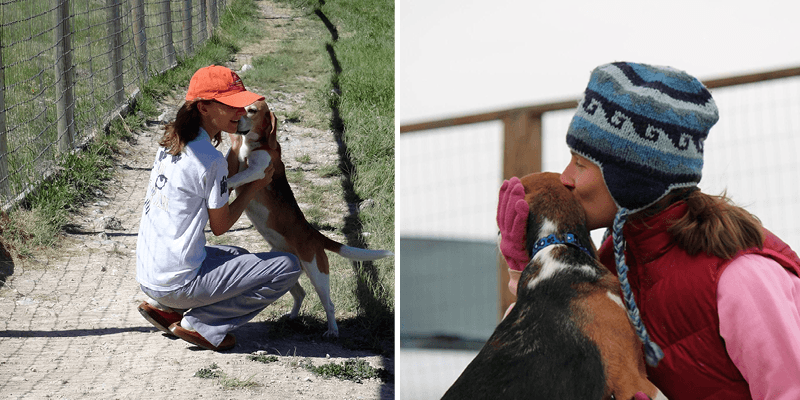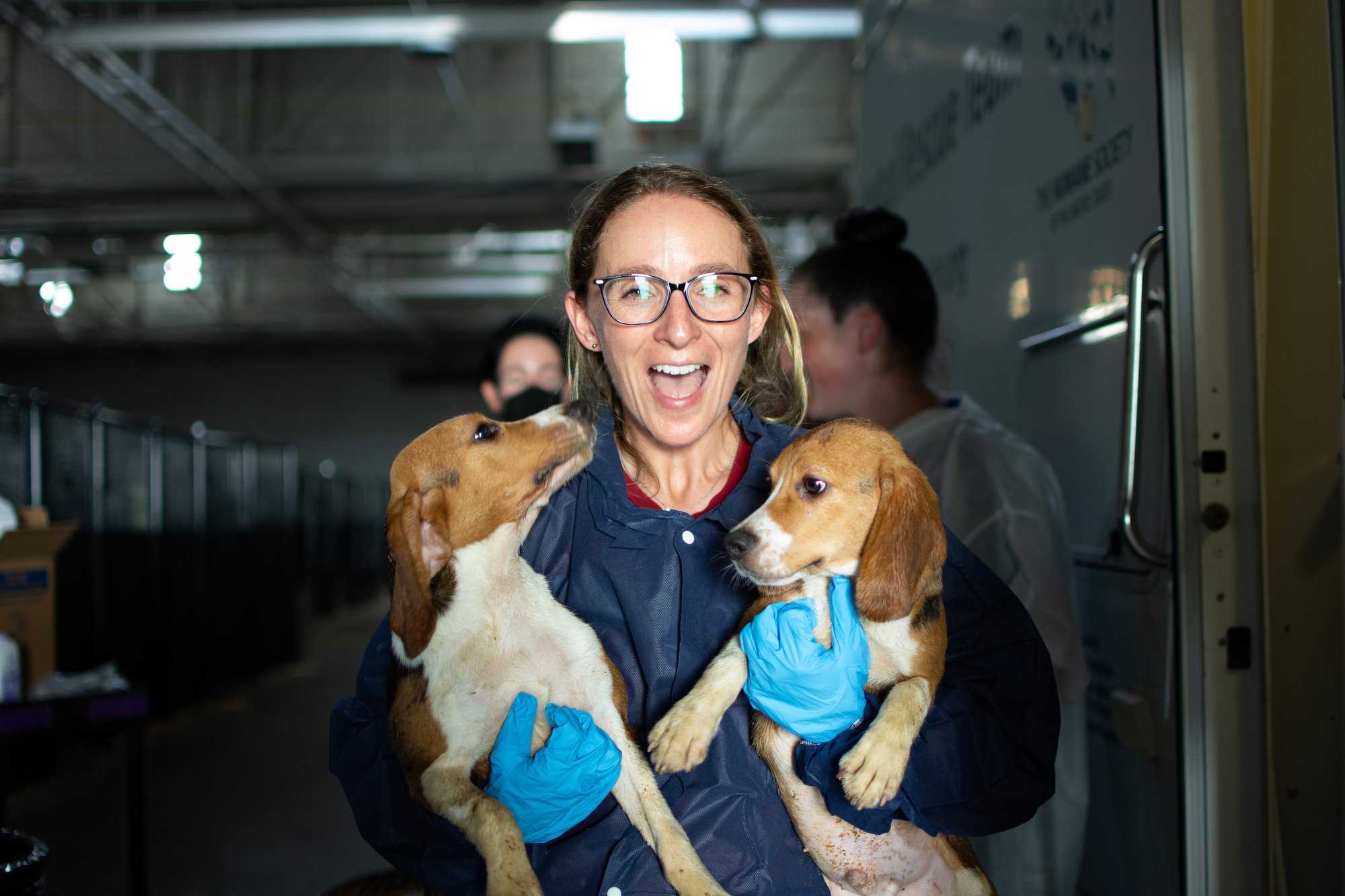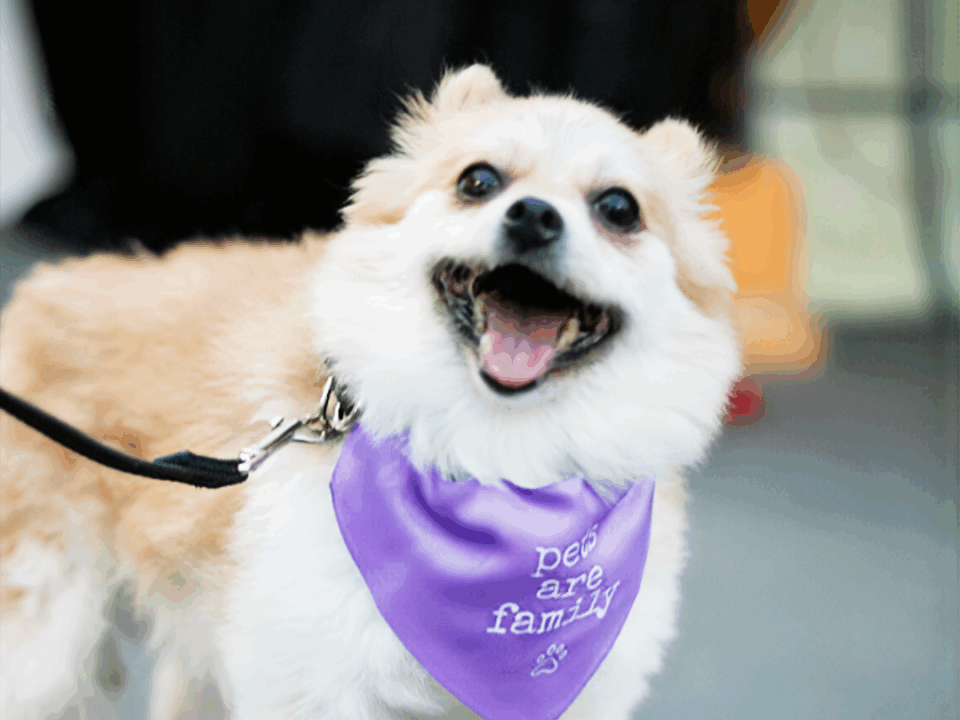Onward and upward for rescued beagles
November 1st, 2022
By Devon Krusko, Field Services and Community Programs Manager
I’ve always been a bit of a wandering soul, leading with my heart and doing what felt right. During college and after graduation, I often felt a bit like I couldn’t quite find my path. Younger me wanted to be a veterinarian, and I worked as a veterinary assistant throughout college and my early 20s. I enjoyed teaching preschool through second grade during the early years of my career, volunteering with local animal rescue groups, and pursuing employment opportunities in the animal welfare field that felt like a distant dream.
In 2014 I found the job that would change my trajectory: a live-in animal caretaker at a sanctuary in Wyoming. This position was unique. Located in Hartville, Wyoming (population: 50), Kindness Ranch Animal Sanctuary is a 1,000-acre ranch for former research and lab animals. After spending a weekend in the yurt that would become my home, it was a whirlwind of quitting my job, selling my house, and moving in with a bunch of former laboratory beagles (“bagels,” as I like to call them), large hounds and mastiffs, and taking care of a plethora of cats, horses, and pigs. The beagles, who had never felt grass or lived in a home setting, utilized the yurt as such. All had behavior plans, specialized care, and began to learn and grow into a pet dog. I think often of my time at Kindness Ranch and my heart carries wonderful memories for the many sentient, inquisitive dogs and other animals I cared for during my time there, especially favorite beagles like Isaac and Molson.

Isaac (left) | Molson (right)
When RedRover was asked this summer to assist our friends at the Humane Society of the United States with their historic effort to remove and place approximately 4,000 beagles from a breeding facility for laboratory testing, I was flooded with emotions for the dogs, their history, and their incredibly rare opportunity to become a beloved family member. What a gift to be involved in this monumental experience, and what an opportunity for education about animal testing and humane practices.
It’s no surprise to many of us in the animal welfare field that almost 60,0001 dogs were used in USDA-registered (i.e., legal and government-sanctioned) research in 2019, even though most animal studies do not yield direct results.2 But as long as the law dictates that clinical trials must be done on animals prior to moving to human studies, the treatment of those animals – whether rodents, rabbits, canines, or non-human primates – must remain at the forefront for all of us. The 4,000 beagles aren’t unique, unfortunately; rather, they are the norm. The facility, owned and operated by Envigo, had over 70 violations of the federal Animal Welfare Act including denying the dogs medical care, withholding food, and not following humane euthanasia guidelines. Puppies died from being crushed by other dogs due to a lack of appropriate space, falling through cracks into drains full of their own excrement, and from cold exposure. No beds, no enrichment, their feet stuck in slatted flooring limiting movement, and never leaving their tiny square… we must do better.
Our first day on the ground in Maryland, I anxiously awaited the transport vehicle to arrive at the Humane Society of the United States’ Animal Care and Rehabilitation Center. I couldn’t wait to see the dogs and get them settled into a clean space where their tiny feet would feel a soft texture for the first time. My dog-trainer-brain ached for the stress and overwhelming unknowns these dogs would experience on this immense day – so many new people, smells, surroundings, and experiences in such a short amount of time. True to their breed, I knew the beagles would be tolerant and accepting of most anything the day would bring – a quality that works to their detriment, as this and their small size make them common candidates for testing.
I stood in line with other volunteers and staff waiting for my turn to be handed a beagle (or two!). I watched my colleagues before me safely cradle our nervous new friends while they were checked in and identified by the tattoos on their ears. Many of the beagles were frozen – a common fear response – but some offered tail wags and tentative kisses. When my turn came I was handed a duo, their warm little buddies nuzzling into my neck as I carried them to their safe space. I whispered that they were safe, and when I placed them down they scrambled to my lap for affection.

It was impossible not to fall for favorite beagles over the next week as we worked to provide daily care for these precious and sweet friends. I wanted to watch them for hours, exploring their space, playing with toys for the first time, and falling asleep in a lap with a big relieved sigh. Each day brought out their unique personalities, silly antics, and the most heartwarming greetings. I have no doubt they will be so very loved by their new families.
I will forever have a soft spot for the animals who come from breeding and laboratory facilities, and I hope my path continues to lead me on a journey where I get to play a small role in their freedom. I’m so grateful to all of the incredible folks who made this rescue possible: to the many animal welfare organizations, staff, volunteers, advocates, donors, media, and adopters – the success of this operation is because of you. Thank you.
Follow us on social media for more updates on our lifesaving deployments:
1 https://news.northeastern.edu/2022/07/21/beagles-lab-testing/
2 https://www.ncbi.nlm.nih.gov/pmc/articles/PMC4594046/






